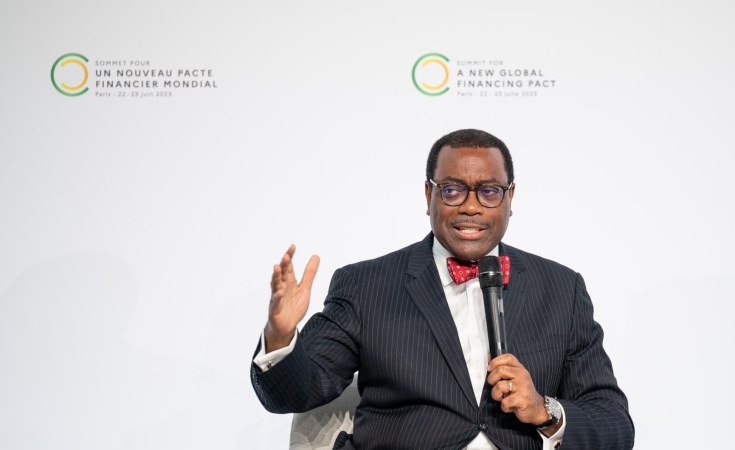Your Excellencies, ladies, and gentlemen.
Thank you for inviting me to speak at this important session on the evolution of the debt landscape over the past 10 years.
The total external debt of Africa was estimated at $1.1 trillion in 2022. This is expected to rise to $1.13 trillion by 2023. This is due to several factors: the carry-over effects of the Covid-19 pandemic on economies and their fiscal space which led to downgrades of several countries; the rising costs of energy and food prices from the Russian-Ukraine war; and the rising costs of adapting to climate change.
With the tightening of monetary policies in the US and Europe, interest rates have risen, leading to rising costs of debt servicing. These combined effects have led to 25 countries in Africa being either at the risk of high debt distress or in debt distress. As a result, the external debt service payments due for 16 African countries will rise from $21.2 billion in 2022 to $22.3 billion in 2023.
The structure of Africa's debt has changed dramatically in the past decade or more, accentuating a trend that started in the mid-2000s.
I would like to discuss five trends.
First, non-Paris Club bilateral creditors and commercial creditors are increasingly becoming major sources of Africa's sovereign debt. While bilateral debt represented 52% in 2000, this declined to 25% by 2021; commercial debt's share of total debt increased from 17% in 2000 to 43% in 2021. Yearly bond issuances in Africa increased from an average of $10 billion annually in the early 2000s, to about $80 billion annually by 2016–2020. This trend was spurred by the very low global interest rates, with investors looking for yields in emerging markets.
Second, there has been a very rapid growth in debt owed to China. The share of China's debt rose from just 1% of total debt in mid-2000s to 14% of total external debt by 2021. Most of this debt is for infrastructure.
Third, average interest rates on debt have diverged significantly over time, with multilateral debt at 1%; bilateral debt at 1.2%; China debt at 3.2%; and private debt at greater than 6.2%. The tenure on debt has also widened between creditors.
Fourth, while the maturity of official debt was 30 years (for 62% of the debt), the tenor for bonds have averaged 10 years. Thus, we now have a more shorter-term debt with higher interest rates.
Fifth, an increasing percentage of debt is now in form of resource-backed loans. Between 2004 and 2018 30 natural resource-backed loans worth $66 billion were signed by African countries. Most of the loans were backed by oil, minerals, and commodities. The commodity price crash of 2014 threw to 10 out of the 14 countries that used natural resource backed loans into serious debt problems.
What needs to be done to tackle Africa's debt?
First, given the diverse nature of creditors, most now outside of the Paris-Club, it has become more complex to address debt treatment, debt restructuring and debt resolution. The process has become more complicated, as interests of creditors diverge. Need to expand the Paris Club to include the commercial and other-non-Paris club creditors. We need to make the G20 Common Framework work and speedily concluded for Zambia, Chad, Ethiopia, and Ghana, to build momentum for debt treatment for all creditors.
Second, there is need for greater debt transparency across all creditors.
Third, given their non-transparent nature, asymmetry of power in negotiations and compromises of countries futures, natural resource backed loans should no longer be used.
Fourth, we must expand market-derived concessional financing to support countries. This will reduce the level of dependency on expensive short-term debt by countries. The ADF market-option of the African Development Bank Group can help mobilize $27 billion for the low-income countries.
Fifth, greater use of partial credit guarantees at scale can help countries to access capital markets and issue bonds at lower coupon rates and longer maturities. For example, the African Development Bank used partial credit guarantees of $375 million to support the issuance of $500 million Panda bond by Egypt. We also used a partial credit guarantee of EUR 195 million to de-risk a EUR 350 million sustainable development loan from Deutsche Bank to Benin.
Sixth, the SDR re-channeling to the African Development Bank can be leveraged by the Bank by 3–4 times to deliver greater financing for African countries. The financial model for SDR re-channeling, with a liquidity support agreement, developed by the Bank and the Inter-American Development Bank has now met the reserve asset status of the IMF. What is needed is for 5 countries to provide SDRs to the Bank. A $5 billion allocation will be turned into $20 Billion of financing for Africa. A $50 billion allocation to multilateral development banks will deliver $200 billion of new lending to countries.
Finally, efforts should be made to tackle systemic risks in Africa. Africa is the only region without liquidity buffers to protect it against shocks. To change this, the African Development Bank and the African Union are working together to establish an African Financial Stability Mechanism. Such a homegrown mechanism will mutualize our funds and ensure that we avoid spillover effects that come from global shocks.
Let's make sustainable debt work well for countries.
Let's support greater domestic resource mobilization for countries.
Let's coordinate better and lower the time and costs of overly long debt resolutions. The debt treatment of the 1990s took over a decade to conclude, which led to the lost decade in Africa's development.
Hope delayed is hope denied.
Thank you very much.



